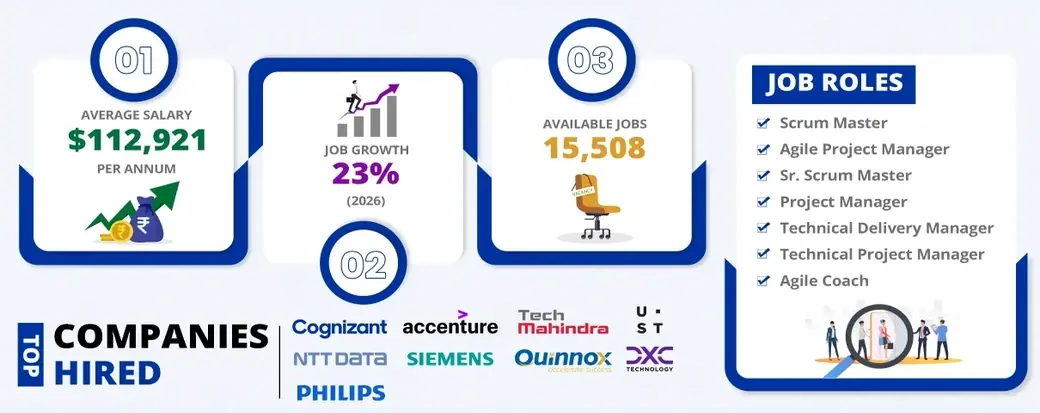Course Objectives
The primary objective of the PSM course curriculum is to provide participants with a comprehensive understanding of the Scrum framework and the skills required to serve as a Scrum Master. By the end of the course, participants will be able to:
- Understand the principles and values of Scrum
- Explain the role of the Scrum Master and their responsibilities
- Facilitate Scrum events and ceremonies
- Remove impediments and improve team dynamics
- Apply Scrum principles to real-world problems
Course Curriculum
The PSM course curriculum is structured around the following topics:
1. Introduction to Scrum: Overview of the Scrum framework, its history, and principles. This module provides a foundational understanding of Scrum and its application in Agile teams.
2. Scrum Roles: In-depth exploration of the Scrum roles, including the Scrum Master, Product Owner, and Development Team. Participants will learn about the responsibilities and expectations of each role and how they interact with each other.
3. Scrum Events: Facilitating Scrum events, including Sprint Planning, Daily Scrum, Sprint Review, and Sprint Retrospective. Participants will learn how to facilitate these events effectively and ensure that they are productive and meaningful.
4. Scrum Artefacts: Understanding Scrum artefacts, including the Product Backlog, Sprint Backlog, and Increment. Participants will learn how to create and manage these artefacts and how they support the Scrum framework.
5. Scrum Master Role: The role of the Scrum Master is to facilitate Scrum teams, removing impediments, and improving team dynamics. Participants will learn about the Scrum Master's responsibilities and how to serve the team and organisation.
6. Agile Principles: Understanding Agile principles and values, and how they relate to Scrum. Participants will learn about the Agile Manifesto and how it guides Scrum practices.
7. Case Studies and Exercises: Hands-on exercises and case studies that help participants apply Scrum principles to real-world problems. Participants will work in teams to complete exercises and discuss case studies, applying Scrum principles to practical scenarios.
with PSM Certification
Benefits of the PSM Certification Course
The PSM course curriculum provides numerous benefits to professionals looking to excel as Scrum Masters or Agile practitioners. Some of the key benefits include:
1. Improved understanding of Scrum principles: Participants gain a deep understanding of the Scrum framework and its principles.
2. Enhanced facilitation skills: Participants learn how to facilitate Scrum events and ceremonies effectively.
3. Increased confidence: Participants gain the confidence to serve as Scrum Masters and facilitate Agile teams.
4. Better team dynamics: Participants learn how to improve team dynamics and remove impediments.
Conclusion
The Professional Scrum Master (PSM) course is a highly acclaimed training program that provides professionals with the knowledge, skills, and best practices required to excel as Scrum Masters in Agile teams. By providing a comprehensive understanding of the Scrum framework and its principles, the course curriculum helps participants gain the confidence and skills required to serve as Scrum Masters and facilitate Agile teams. If you're looking to deepen your understanding of Scrum and Agile, the PSM course is an excellent choice.
FAQs
1. What topics are covered in the PSM course curriculum?
The PSM course curriculum covers topics such as Scrum framework, Scrum roles, Scrum events, Scrum artifacts, and Agile principles. It provides a comprehensive understanding of Scrum and the role of the Scrum Master.
2. Is the PSM course curriculum based on the latest Scrum Guide?
Yes, the PSM course curriculum is based on the latest Scrum Guide and is designed to provide participants with a deep understanding of Scrum principles and practices.
3. What kind of activities can I expect in a PSM course?
In a PSM course, you can expect a mix of lectures, discussions, and hands-on exercises that help you learn and apply Scrum principles in real-world settings. The course is designed to be interactive and engaging, with opportunities to ask questions and learn from the instructor and other participants.







 The Professional Scrum Master (PSM) course is a highly acclaimed training program designed to equip professionals with the knowledge, skills, and best practices required to excel as Scrum Masters in Agile teams.
The Professional Scrum Master (PSM) course is a highly acclaimed training program designed to equip professionals with the knowledge, skills, and best practices required to excel as Scrum Masters in Agile teams. 






